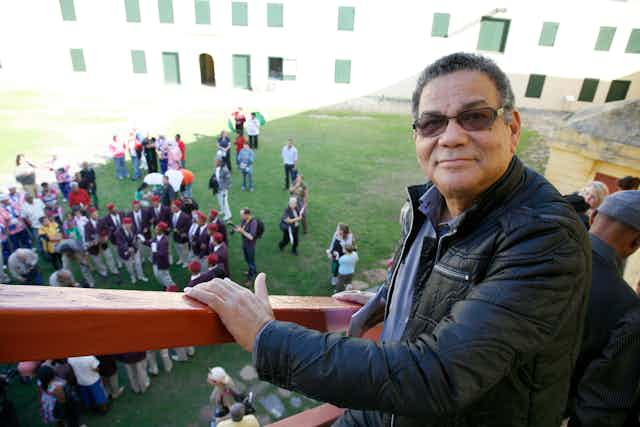When Professor Henry Charles “Jatti” Bredekamp began his career as a historian of early Cape Town in South Africa, there was still a commonly held myth that the region’s native people, the Khoisan, had “all but disappeared”. This was in the wake of slavery, colonialism and apartheid, a system of racial segregation by white minority rule.
Bredekamp, who passed away in September 2023, was central in debunking this myth. Aside from his scholarship, he will be remembered for his influential role as a public historian and a conduit for the revival of Khoisan indigenous identity. Many within the movement fondly refer to him as the father of Khoisan revivalism.
Read more: Rock art: how South Africa's coat of arms got to feature an ancient San painting
I interviewed Bredekamp and other “Khoisan revivalists” over several years for my book Khoisan Consciousness. I believe that Bredekamp’s fascinating life story continues to speak to the present moment, when people are proudly identifying as Khoisan and demanding historical justice after being suppressed for centuries.
In fact, Khoisan revivalism’s origins, driving forces and tribulations simply cannot be understood without taking into account Bredekamp’s living legacy: moving conversations on Khoisan history and identity out of the ivory tower of the academy and onto the streets.
Who was Henry Bredekamp?
Bredekamp (born in 1945) served as chief executive of the Iziko Museums of Cape Town, president of the South African national committee of the International Council of Museums and interim chief executive of Robben Island Museum.
He was the first academic historian of colour to be employed by a South African university. In 1976 he left his job as a farm school teacher in the Great Karoo and accepted a position as lecturer-researcher at the University of the Western Cape.
Born and raised in Genadendal, a mission station originally aimed at converting the local Khoisan, Bredekamp had always been aware of his indigenous heritage. He began to assert this lineage more prominently as he established himself in academia.
He went against the current by focusing his research on the Khoisan’s resistance to, and mistreatment by, the colonial oppressors. He steered his career towards public history and spreading awareness about Khoisan history.
A decisive moment occurred during a Khoisan Studies conference in Germany in 1994. Realising he was the only African delegate, Bredekamp made a heartfelt plea to the audience to “recover our past and our traditions”. In essence, he was exploring the possibilities of a collaboration between activism and academia that would kickstart Khoisan revivalism.
The big picture
To understand Khoisan revivalism, one has to back up several centuries. As Europeans settled on South African shores in the mid-1600s, the local Khoisan (also known as Khoi and San) were violently dispossessed of the land they had been living on for centuries. Those who did not perish in their resistance were forcefully assimilated into colonial society. They were made to renounce their indigenous cultures, languages and belief systems. They had to give up their traditional hunter-gatherer and cattle-herding modes of subsistence.
The Khoisan were eventually classified as “Coloured” under the apartheid system of the 1900s. The label described those of mixed “racial” origins and fitted between “White” and “Black” in the racial hierarchy. As a result, most South Africans believed the Khoisan had disappeared, except for a few “pure” communities in the Kalahari Desert.
This “extinction discourse” has especially been challenged since apartheid’s demise in the 1990s. Increasing numbers of people once again proudly call themselves Khoisan, particularly in urban areas.
Khoisan revivalism
Examples of Khoisan revivalism abound in South Africa today. It can be seen in activists occupying ancestral land in Grabouw. In the fight against property development on what some Khoisan revivalists claim is sacred land. In the landmark benefit-sharing agreement recognising Rooibos (a plant famous as a tea) as Khoisan traditional knowledge.

But when did the movement begin? I started looking for answers about a decade ago, focusing on the perspectives of the Khoisan revivalists themselves. Why did they turn to Khoisan identity and what did they hope to achieve?
Khoisan revivalists are a diverse group. There are longstanding disputes over leadership positions, political strategy and the boundaries of Khoisan identity. However, they all arguably seek to instil a sense of pride and ownership among those who once again identify as Khoisan. These core values were articulated by the earliest Khoisan revivalists, not least Bredekamp.
Bredekamp’s influence
Bredekamp was the main organiser of the 1997 Khoisan Identities and Cultural Heritage Conference in Cape Town. It was distinct from earlier versions because of its active recruitment of Khoisan participants. They brought their grievances and calls for indigenous rights directly to the audience. Bredekamp hailed this as the beginning of a battle for identity. He ensured that the follow-up edition produced concrete policy recommendations.
However, he soon become disheartened by what he regarded as the rise of self-proclaimed Khoisan “chiefs” who didn’t provide solid historical evidence to back up their claims. Some were unscrupulously looking to enrich themselves. Relaying these concerns to the South African government in his consultancy work, Bredekamp insisted that all claims for recognition as Khoisan traditional leaders be thoroughly vetted. He also somewhat surprisingly advised against granting the Khoisan statutory recognition as indigenous people, a contentious issue to this day. As far as Bredekamp was concerned, many had turned the Khoisan revivalist movement into a charade, divorced from its original emphasis on heritage, culture and language.
Considering the bold claims made by some Khoisan leaders, Bredekamp’s concerns remain pertinent. He insisted on historical criticism, while remaining attentive to the plight of a people he understood intimately.
Tensions surrounding decolonisation also remain as relevant as they were in 1997. Some of those Bredekamp influenced actively, such as South African academics June Bam or Yvette Abrahams, seek to include grassroots movements in academia. Taking history to the people and the people to history seems to be Bredekamp’s most enduring legacy.

